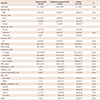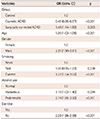1. Lopez AD, Mathers CD, Ezzati M, Jamison DT, Murray CJ. Global and regional burden of disease and risk factors, 2001: systematic analysis of population health data. Lancet. 2006; 367:1747–1757.
2. de Fatima Marinho de Souza M, Gawryszewski VP, Orduñez P, Sanhueza A, Espinal MA. Cardiovascular disease mortality in the Americas: current trends and disparities. Heart. 2012; 98:1207–1212.
5. Somerville J. Management of adults with congenital heart disease: an increasing problem. Annu Rev Med. 1997; 48:283–293.
6. Moon JR, Lee HJ. Transitioning adolescents with congenital heart disease in to adult health care. J Korean Pediatr Cardiol Soc. 2004; 8:135–141.
7. Goff DC Jr, Lloyd-Jones DM, Bennett G, et al. 2013 ACC/AHA guideline on the assessment of cardiovascular risk: a report of the American College of Cardiology/American Heart Association task force on practice guidelines. Circulation. 2014; 129:25 Suppl 2. S49–S73.
8. Jang SY, Ju EY, Cho SI, Lee SW, Kim DK. Comparison of cardiovascular risk factors for peripheral artery disease and coronary artery disease in the korean population. Korean Circ J. 2013; 43:316–328.
9. World Health Organization Western Pacific Region, International Association for the Study of Obesity, International Obesity Task Force. The Asia-Pacific perspective: redefining obesity and its treatment. Sydney: Health Communications;2000.
10. Yoon YS, Oh SW, Baik HW, Park HS, Kim WY. Alcohol consumption and the metabolic syndrome in Korean adults: the 1998 Korean National Health and Nutrition Examination Survey. Am J Clin Nutr. 2004; 80:217–224.
11. Babor TF, Higgins-Biddle JC, Saunders JB, Monteiro MG. The alcohol use disorders identification test - guidelines for use in primary care. Geneva: World Health Organization;2001.
13. Expert Panel on Detection, Evaluation, and Treatment of High Blood Cholesterol in Adults. Executive summary of the third report of the National Cholesterol Education Program (NCEP) expert panel on detection, evaluation, and treatment of high blood cholesterol in adults (Adult Treatment Panel III). JAMA. 2001; 285:2486–2497.
14. Third report of the National Cholesterol Education Program (NCEP) expert panel on detection, evaluation, and treatment of high blood cholesterol in adults (Adult Treatment Panel III). The guidelines [Internet]. Accessed on Mar 12, 2014. Available from:
http://www.nhlbi.nih.gov/guidelines/cholesterol/index.htm.
15. Després JP, Lemieux I. Abdominal obesity and metabolic syndrome. Nature. 2006; 444:881–887.
16. Grundy SM. What is the contribution of obesity to the metabolic syndrome? Endocrinol Metab Clin North Am. 2004; 33:267–282.
17. Kim MH, Kim MK, Choi BY, Shin YJ. Prevalence of the metabolic syndrome and its association with cardiovascular diseases in Korea. J Korean Med Sci. 2004; 19:195–201.
18. Rhee MY, Kim JH, Kim YS, et al. High sodium intake in women with metabolic syndrome. Korean Circ J. 2014; 44:30–36.
19. Steinberger J, Daniels SR. American Heart Association Atherosclerosis, Hypertension, and Obesity in the Young Committee (Council on Cardiovascular Disease in the Young). American Heart Association Diabetes Committee (Council on Nutrition, Physical Activity, and Metabolism). Obesity, insulin resistance, diabetes, and cardiovascular risk in children: an American Heart Association scientific statement from the atherosclerosis, hypertension, and obesity in the young committee (Council on Cardiovascular Disease in the Young) and the diabetes committee (Council on Nutrition, Physical Activity, and Metabolism). Circulation. 2003; 107:1448–1453.
20. Martínez-Quintana E, Rodríguez-González F, Nieto-Lago V, Nóvoa FJ, López-Rios L, Riaño-Ruiz M. Serum glucose and lipid levels in adult congenital heart disease patients. Metabolism. 2010; 59:1642–1648.
21. Gidding SS, Bao W, Srinivasan SR, Berenson GS. Effects of secular trends in obesity on coronary risk factors in children: the Bogalusa Heart Study. J Pediatr. 1995; 127:868–874.
22. King VL, Hatch NW, Chan HW, de Beer MC, de Beer FC, Tannock LR. A murine model of obesity with accelerated atherosclerosis. Obesity (Silver Spring). 2010; 18:35–41.
23. Vasconcelos IQ, Stabelini Neto A, Mascarenhas LP, et al. Cardiovascular risk factors in adolescents with different levels of energy expenditure. Arq Bras Cardiol. 2008; 91:207–212. 227–233.
24. Varady KA, Jones PJ. Combination diet and exercise interventions for the treatment of dyslipidemia: an effective preliminary strategy to lower cholesterol levels? J Nutr. 2005; 135:1829–1835.
25. Reybrouck T, Mertens L. Physical performance and physical activity in grown-up congenital heart disease. Eur J Cardiovasc Prev Rehabil. 2005; 12:498–502.
26. Fyfe A, Perloff JK, Niwa K, Child JS, Miner PD. Cyanotic congenital heart disease and coronary artery atherogenesis. Am J Cardiol. 2005; 96:283–290.
27. Hait G, Corpus M, Lamarre FR, Yuan SH, Kypson J, Cheng G. Alteration of glucose and insulin metabolism in congenital heart disease. Circulation. 1972; 46:333–346.
28. Lundell KH, Sabel KG, Eriksson BO, Mellgren G. Glucose metabolism and insulin secretion in children with cyanotic congenital heart disease. Acta Paediatr. 1997; 86:1082–1084.
29. Kavey RE, Allada V, Daniels SR, et al. Cardiovascular risk reduction in high-risk pediatric patients: a scientific statement from the American Heart Association Expert Panel on population and prevention science; the Councils on Cardiovascular Disease in the Young, epidemiology and prevention, nutrition, physical activity and metabolism, high blood pressure research, cardiovascular nursing, and the kidney in heart eisease; and the interdisciplinary working group on quality of care and outcomes research: endorsed by the American Academy of Pediatrics. Circulation. 2006; 114:2710–2738.








 PDF
PDF ePub
ePub Citation
Citation Print
Print


 XML Download
XML Download